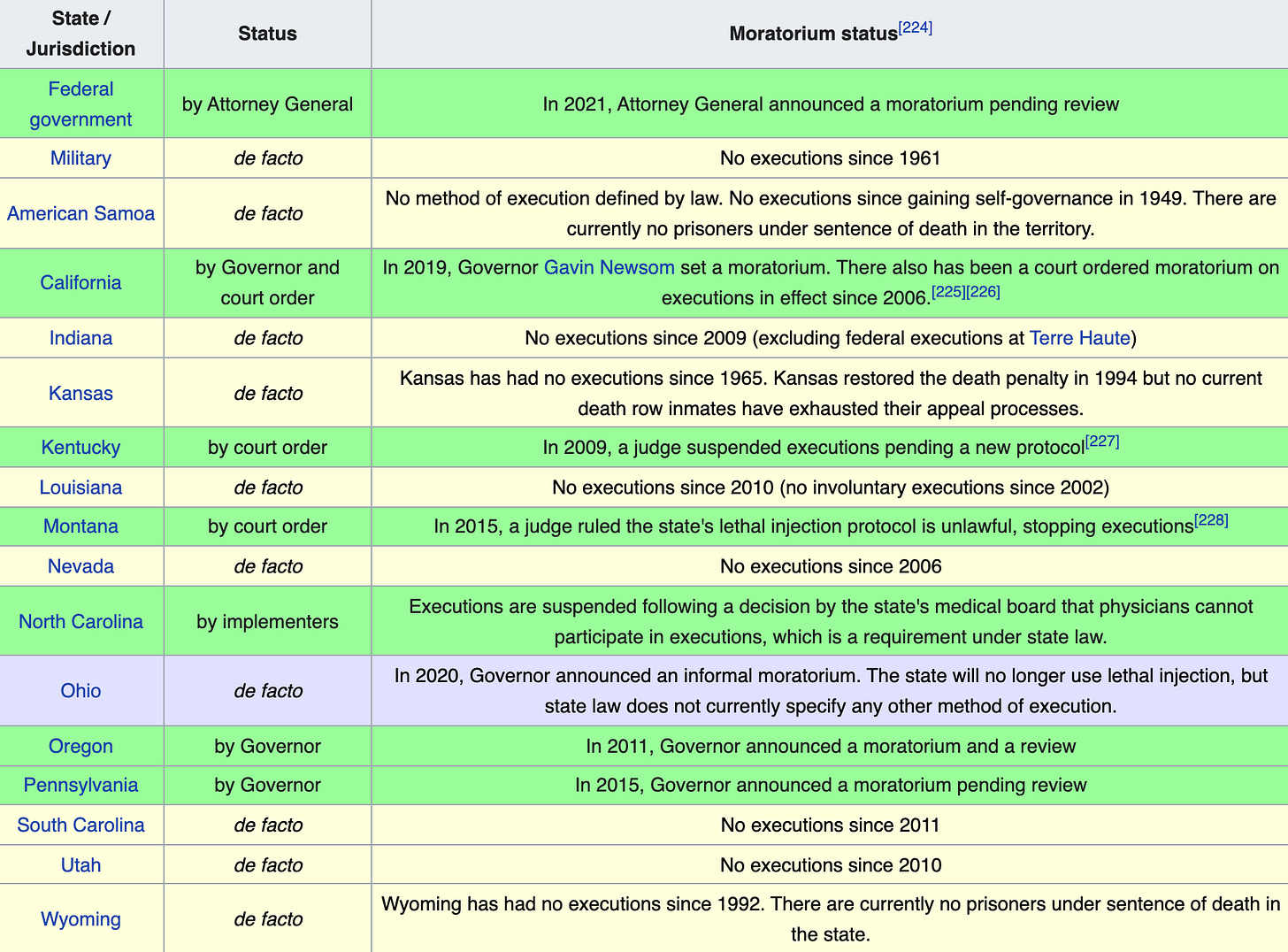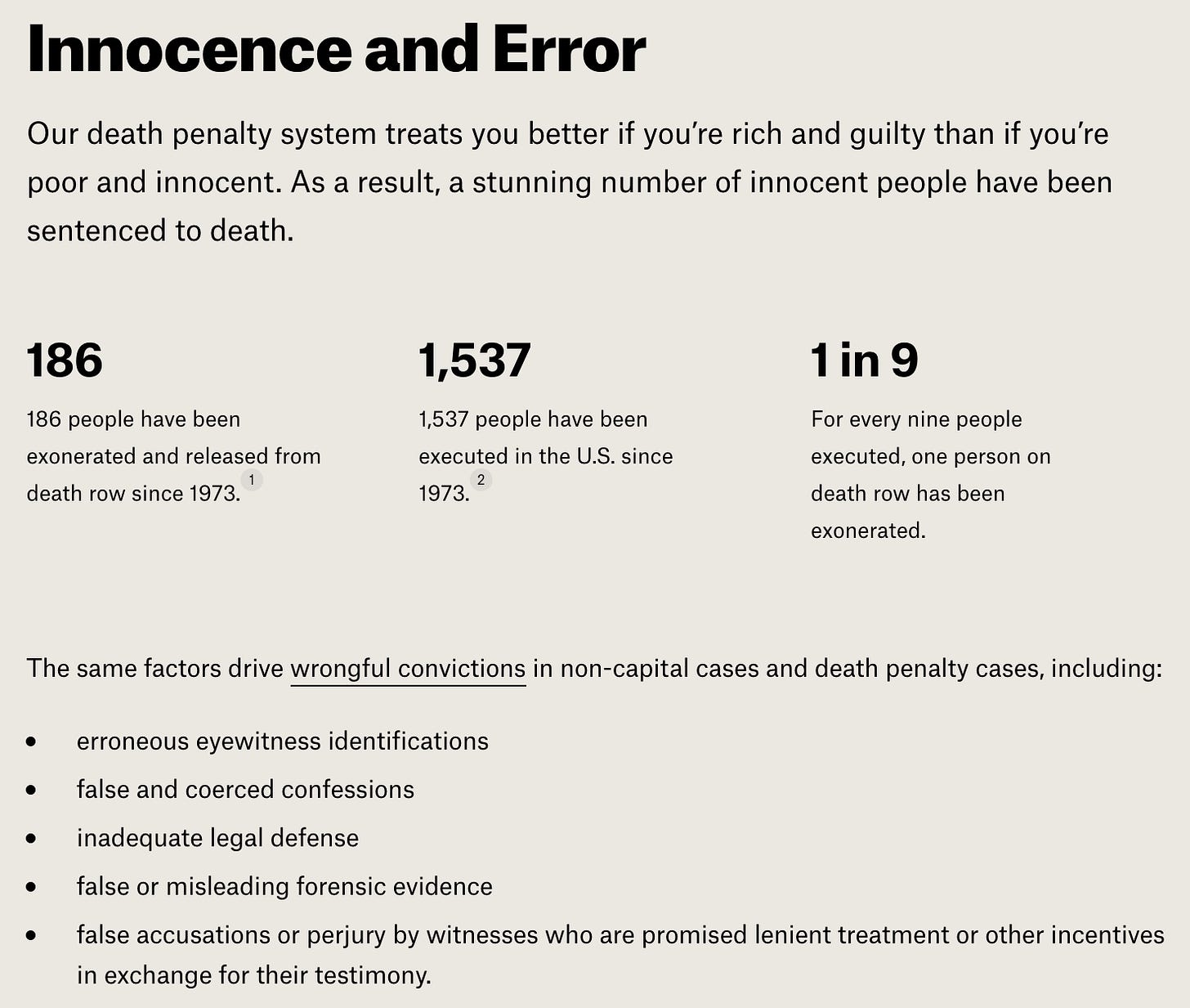Death! To None of Them!!
Stop! In the name of justice! Before you execute someone else!!
We’ve covered a number of heavy topics here at E4P with a haphazard grace and mediocre comedy, from prison reform to the second amendment, to the economy. Turning on that ol’ charm again today, we’re going to talk about death (But more specifically, the death penalty.)
Today, we’re looking at what capital punishment technically entails, how it currently exists across America, and the specifics of Julius Jones’ case in Oklahoma.

A Murder By Any Other Name is Still Murder
Death is a weird thing, isn’t it? One second, someone’s alive and the next, the federal government is sticking a lethal drug cocktail into them.
Capital punishment, the formal name for an execution carried out as a sentence for a crime, has existed in the US since 1608. From then until 2002, 15,269 civilians were executed while the “United States Army [has] executed 135 soldiers between 1916 and 1955.”

While the death penalty has never been totally abolished by the federal government or the military, the military has not executed any soldiers since 1955. The federal government did not execute anyone between 2003 and 2019, creating an informal moratorium, but then President Trump and Attorney General Bill Barr wanted to spice things up and reintroduced it, resulting in 10 executions in 2020 and 3 in 2021.1
Additionally, the Supreme Court decided in the 1972 case Furman v. Georgia that all death penalty cases in the country should be invalidated. However, they included a stipulation that “in order to reinstate the death penalty, states had to at least remove arbitrary and discriminatory effects in order to satisfy the Eighth Amendment to the U.S. Constitution.”
The legality of the death penalty was then re-confirmed by the 1976 SCOTUS decision in Gregg v. Georgia. (And now I’m thinking: “Damn, maybe I should go as Elle Woods for Halloween.”)
Today, execution is “a legal punishment in 27 states, American Samoa, the federal government, and the military. Although it is a legal penalty in 27 states, only 21 states have the ability to execute death sentences, with the other 6, as well as the federal government, being subject to different types of moratoriums.” (x)2
That’s all the facts and figures. But what is it actually all for?

Murder! At the Disco
In doing research for this piece, I was hard-pressed to find an article solely in favor of the death penalty. Britannica, the fancy name for the encyclopedia, has a Pro/Con spin-off and its debate on the death penalty lists the #3 argument is “Proponents who argue that the death penalty is a deterrent to capital crimes state that such a harsh penalty is needed to discourage people from murder and terrorism.”
According to the ACLU,
“There is no credible evidence that the death penalty deters crime more effectively than long terms of imprisonment. States that have death penalty laws do not have lower crime rates or murder rates than states without such laws. And states that have abolished capital punishment show no significant changes in either crime or murder rates.
The death penalty has no deterrent effect. Claims that each execution deters a certain number of murders have been thoroughly discredited by social science research. People commit murders largely in the heat of passion, under the influence of alcohol or drugs, or because they are mentally ill, giving little or no thought to the possible consequences of their acts. The few murderers who plan their crimes beforehand —for example, professional executioners— intend and expect to avoid punishment altogether by not getting caught. Some self-destructive individuals may even hope they will be caught and executed.”
Additionally, the #1 argument for the death penalty is: “Proponents of the death penalty being legal argue that such a harsh penalty is needed for criminals who have committed the worst crimes, that the punishment deters crime, and that the US Supreme Court has upheld the death penalty as constitutional.”
The issue here is that this is not true. As of 2019, at least 4% of inmates on death row are innocent. America has a problem with wrongful convictions (due to our other issue of mass incarceration), and cases that result in the death penalty are no different than the countless other cases across the country. The Equal Justice Initiative has found the following:

Many people believe that because executions are so dramatic and final, they are the result of airtight cases and are reserved for the worst of the worst which is why they remain supportive of the death penalty. But what happens when that is not the case? (Incredible segue.)
Team Julius
Julius Jones is a man on death row in Oklahoma for a 1999 murder he did not commit. In addition to Jones maintaining his innocence since his arrest, the facts are:
-Christopher Jordan, the state’s star witness who claims to have been a get-away-driver but not the triggerman, has confessed multiple times to multiple people that he is the real murderer, and that he set Julius up to receive a reduced sentence. There are videos and sworn affidavits from multiple people, none of whom know each other, attesting to this fact.
-Julius has an alibi— he was home with his parents and sister when the murder occurred. His inexperienced and unprepared legal team failed to present that alibi at trial or to call either Julius or his family to the stand.
-Julius did not match the description of the killer. The only eyewitness described a man with 1-2 inches of hair. Julius had a shaved head. Christopher Jordan, however, had braids that met that description. (x)
On top of that, race played a huge role in Jones’s sentencing, as “a juror on Julius’ case referred to him as the “n-word” and said they might as well take him
behind the courthouse and shoot him. Eleven of the 12 jurors in his trial were white.” As the EJI writes on their website, “people of color are more likely to be prosecuted for capital murder, sentenced to death, and executed, especially if the victim in the case is white” which is exactly the case for Jones.
Jones has a clemency hearing tomorrow which is his last chance to be taken off of death row. The situation in Oklahoma right now is tense as five men on death row —including Jones— could have had their executions stayed today until “a federal judge in Oklahoma ruled Monday the state can move forward with scheduled lethal injections for five death row.” Oklahoma hasn’t carried out the punishment against any inmates in six years after a series of botched executions put everything on pause and the lawsuit they were involved in alleged “the state hasn’t changed its ways since it graphically executed multiple people with the wrong drugs.”
If Jones’ clemency plea is rejected, he will be executed on November 28th by lethal injection.
But It’s All Legal… Right?
Legal? Yes. Humane? Now That’s What I Call the Question.
I personally don’t believe execution by any method to be humane (I don’t know what gave that away), but I especially don’t think we should continue treating lethal injections as if they’re any better than the other methods.
John Oliver did an episode two years ago on lethal injections specifically and the reaction they cause in inmates receiving them that is as horrifying to hear as it is necessary to be told:
There are two different forms of injections (a three drug cocktail or a one drug shot). Oklahoma is one such state that uses the three drug cocktail, which, according to autopsy reports “make prisoners feel like they’re being drowned via a ‘flash pulmonary edema’ as well as ‘burned alive.’”
If you’re someone who believes lethal injection is the best and most ethical way to carry out an execution then babes, I don’t know how to tell you this but murder in any form is still murder. Even though the other six men on death row with Julius Jones are guilty, it isn’t justice if we murder them as a punishment for their crimes. On their website, the EJI argues that “a person doesn’t have to be innocent to be wrongly sentenced to death.” Life imprisonment is what prisons should be for not, as we learned with Liz Pittenger, whatever the fuck they’re actually doing right now.3
The death penalty is another issue tied up with so many other complexities and institutions in desperate need of reform that should probably be figured out first. But until we get there, let’s maybe stop killing people???
I think (know) it was Harvey Dent in the 2008 Christopher Nolan film The Dark Knight (somewhere in the middle when Bruce Wayne crashed Harvey and Rachel’s date with the premier ballerina) that said: “You either die a hero or you live long enough to see yourself become the villain.”4
I hate to break it to everyone but I think we might be the real murderers here.5
Thank you to everyone who reads down this far!!! I know articles with just me talking aren’t as fun but hey— hope you learned a little something about the death penalty today! And a quick shoutout to my favorite person ever executed by the federal government, Ethel Rosenberg. Please read about her role in the espionage case and her botched execution, then watch Meryl Streep absolutely slay in HBO’s Angels in America.
You can take action to support Julius Jones here!!!
The federal government is now tied with Texas for most executions.
I would also like to point out that the US consistently votes against the United Nations Moratorium on the Use of the Death Penalty, most recently in December 2020.
Fun fact: many victims and families of victims of those who have ended up on death row don’t necessarily favor the death penalty. A recent example is when capital punishment was overturned for the surviving perpetrator of the 2013 Boston Bombing last year, the reaction amongst survivors was split.
Very elite few knew my obsession with The Dark Knight Trilogy until just now.
This whole time I was priming myself for an Only Murders in the Building joke and I MISSED IT!!!!


